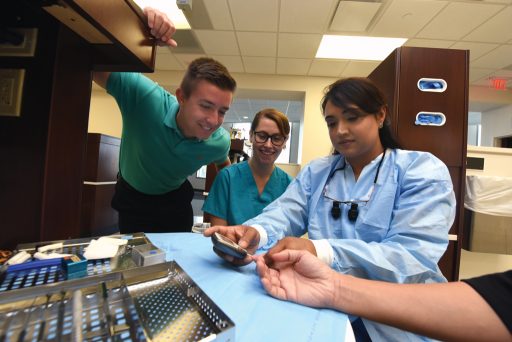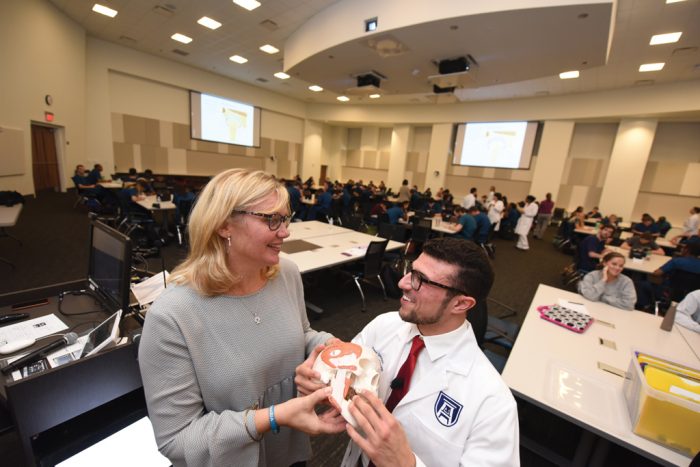Program Cultivates Interests of Aspiring Academicians
We have so many opportunities to explore our passions right at our fingertips.”
That’s Matthew Giordano’s assessment of his education at The Dental College of Georgia, and college administrators have recently gone one step further in making themselves optimally worthy of the accolade.
Last year, Dean Carol A. Lefebvre asked Dr. Kate Ciarrocca, assistant professor in the Department of Oral Rehabilitation, to launch a fellowship program cultivating the interest of DCG students interested in academic careers.
The result, the DCG Academic Dental Careers Fellowship Program, launched as a pilot project this fall. “The fellowship program started in 2006 with a startup grant from the American Dental Association and is now administered and supported by the American Dental Education Association,” Ciarrocca explains. “The purpose is to connect a dental student or fellow with a faculty mentor to provide insight into the day-to-day life of an educator or researcher in academic dentistry. The overarching goal is to encourage students to pursue an academic career.”
Smoothing the Path
Academic dentistry — educating future generations of dentists and continually infusing the discipline with new knowledge and expertise — is one of the most important roles of dentistry, Ciarrocca says. Yet the career path is often overlooked by dental graduates, and dental schools nationwide are continually seeking ways to ensure a steady source of excellent faculty talent. That was the impetus for the ADEA to continue the fellowship program, and the dental college was eager to jump aboard.
“Dental education is something I’m very passionate about,” Ciarrocca says. “I’ve always been on the lookout for students I thought could be great teachers. I would discuss that option with them, but prior to this year, there was no formal program I could direct them to. This fills that gap. We are always looking for the future of dental education, and this is a concrete way for students to learn about it.”
Students who applied were required to conceptualize a yearlong educational project, create a time line and action plan for its completion and identify a mentor -— a DCG faculty member who agreed to the role — with whom to partner. “This is a very big commitment, which in itself weeds out students who aren’t really interested,” Ciarrocca says. “The participants we selected are those who clearly have a passion for education. It’s a lot of work and scheduling, so this is intended for students who have a genuine interest.”
Transforming Into Experts
Seven students were selected as this year’s participants, and Ciarrocca, who herself is serving as a mentor, is thrilled with how it is unfolding. Her mentee, Giordano, plans to study Ciarrocca’s teaching style and methods, then deliver one of her lectures to a first-year class. “It’s really exciting for him,” Ciarrocca says. “It gives him the opportunity to be an ‘expert’ and teach in a classroom setting.”
Says Giordano, “This is giving me a clearer vision of what it means to be a dental educator. I’ve always enjoyed teaching informally as a tutor to my classmates, so I am excited to see what formal teaching will be like.”
This is the spark, Ciarrocca says, that she and her colleagues look for in potential educators. “They’re all kind of natural teachers,” she says. “They want to help their classmates and share knowledge. They’re very collaborative, and they’re in it to help others; that’s very easily identifiable. You can see in classrooms the ones helping others and offering advice in a welcoming way. They’re also able to explain concepts in a manner that’s easily understood.”
Charisma, she says, is also a component of effective teaching — and one that Giordano has in spades. “Matt has a vibrant, happy personality and loves to help others,” she says. “He has a passion for it.”
Connecting Face to Face
Says Giordano, “Dr. Ciarrocca has given me a ton of information already, and I am looking forward to learning more. Ever since I decided to be a dentist, I thought it would be so cool to teach at some point in my career. I can’t help but be drawn to the opportunity to pass down what was given to me by our own faculty members: a passion for learning and delivering outstanding dental care. It would be amazing to one day hold a faculty or administrative position.”
Michael Hampton, another participant, concurs. “I’ve always enjoyed working with and helping others, and I’ve found that the things I’ve been most fascinated in are dentistry and education. I’m hoping to learn more about being a dental educator and that I become a better teacher and speaker in general.”
Ciarrocca notes that the program immerses the fellows extensively in the different roles in academia. Part of the project, she says, is for them to meet with, interview and observe DCG faculty and administrators, both individually and as a group. “This is an integral part of the program, along with bimonthly meetings with mentors,” she says. “Face-to-face meetings are encouraged; it really cements the connection.”
 A Broad Scope
A Broad Scope
The scope of the students’ projects also demonstrates that education takes place both in and out of the classroom, and with a variety of “students” — including patients. Dental student Marlina Manhiani’s project, for instance, involves diabetes screening for DCG patients.
Says Manhiani’s mentor, Dr. Scott De Rossi, “We’re going to be screening for diabetes in our new patient admissions clinic, then come up with an educational module of how dentists can play a role in addressing undiagnosed or uncontrolled diabetes.
“Our focus is on blood-testing,” adds De Rossi, professor in the Department of Oral Health and Diagnostic Sciences. “Millions of Americans with undiagnosed diabetes go to dental offices. We’re in a prime position to become part of the primary health care system. We already routinely screen for hypertension. Diabetes screening is easy and fairly cost-effective, and certainly our patient population in this part of the country is at risk.”
Merging Passions
Says Manhiani, a fourth-year dental student who already has earned her PhD, “I have a research background and would like to merge my previous research with my dental path. I feel this fellowship is giving me that opportunity.”
“These types of programs are absolutely necessary to maintain the lifeblood of our profession,” De Rossi says.
Dr. Bill Bachand, associate professor in the Department of Oral Rehabilitation and another mentor in the program, concurs. “I wanted to get involved with this program because I was intrigued by the thought of students being interested in academia,” he says. “Many of our faculty, including myself, come from second careers, and academia in general has a difficult time attracting new graduates into the profession. Teaching is a very rewarding part of dentistry, and I hope to instill the desire to teach in our fellowship participants.”
EVOLVING PERCEPTIONS
Each student wrote an essay at the beginning of the fellowship articulating what they hope to get out of the experience, then will write another at the end of the year reflecting on what they have learned. “The essays will demonstrate their changing perceptions,” Ciarrocca says.
The projects will be presented at the dental college’s annual Table Clinic Day, and a panel of judges will award prizes. Award-winning participants will attend the American Dental Education Association meeting this spring in Los Angeles, all expenses paid. Ciarrocca will also host luncheons and other activities for participants. “Because it’s a pilot year,” she says, “we’re all learning together. But so far, it’s been awesome.”
The most rewarding part, De Rossi says, is showing the participants something he’s known for years. “For me,” he says, “an academic career provides tremendous variety. Every day is different — teaching, research, patient care, administrative work — and the variety provides a very balanced career. The ability to impact students’ lives and careers is by far the most rewarding aspect, and it’s not even close.”
“I’ve always been on the lookout for students I thought could be great teachers.” —Dr. Kate Ciarrocca










